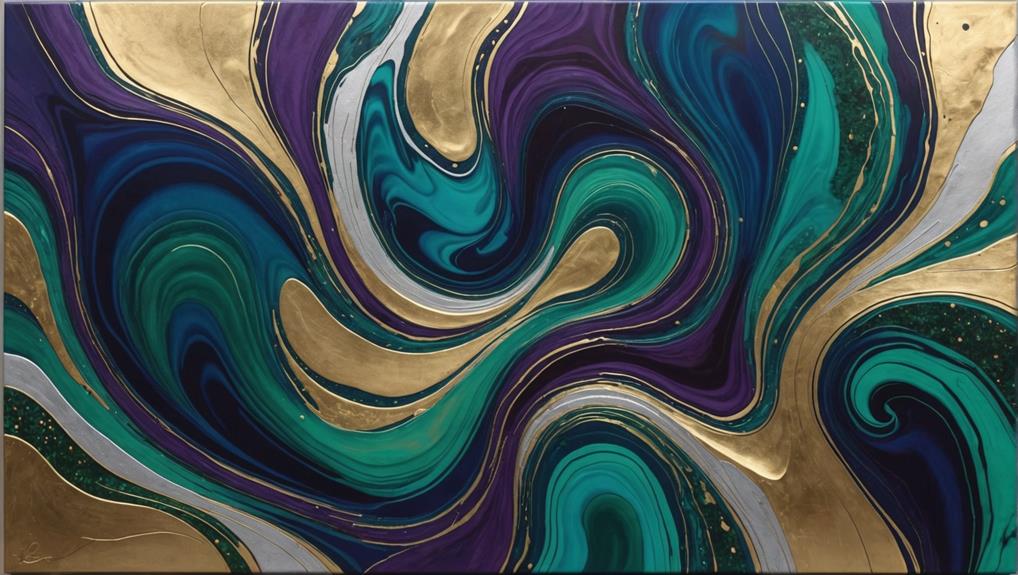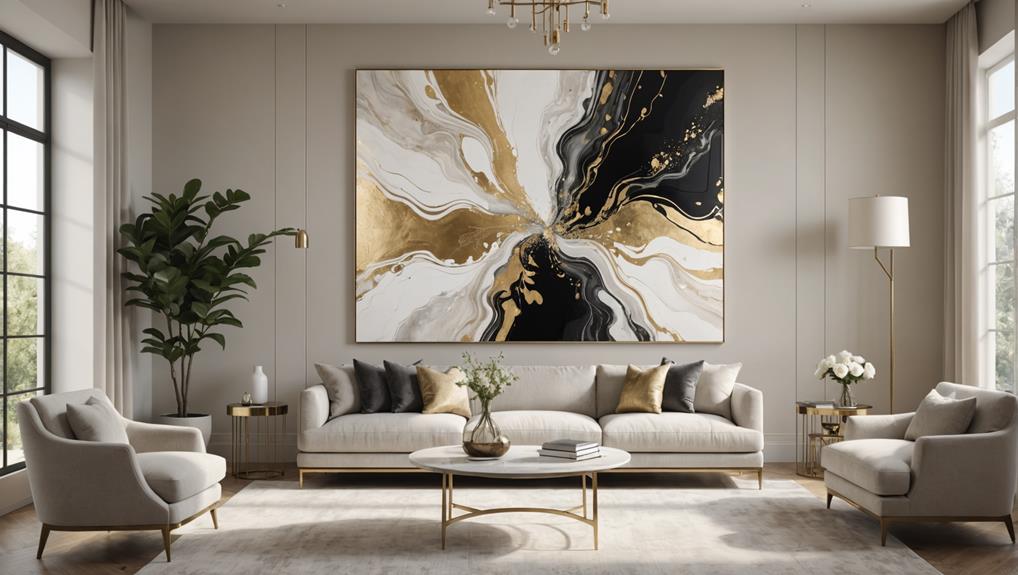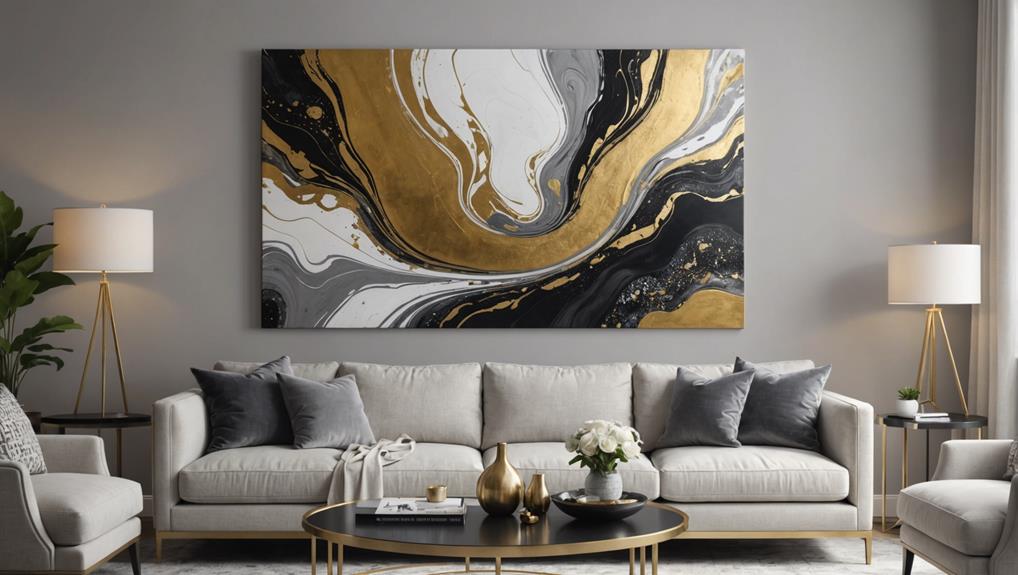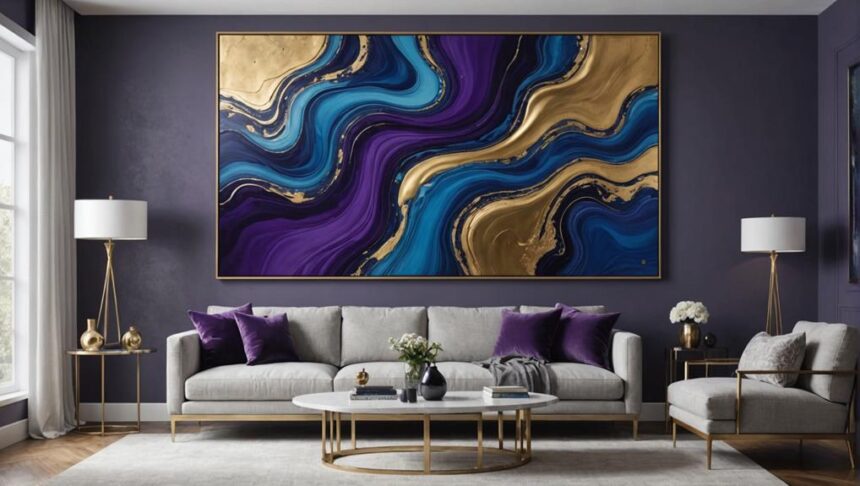Fluid art, or acrylic pouring, is all the rage in home decor, especially with the dazzling addition of metallic accents. Imagine watching paint glide and swirl into vibrant, unpredictable patterns, only to be enhanced by glistening golds, silvers, and coppers. It’s like creating treasures for your walls! These shimmering touches add an elegant flair, making each piece truly unique and sophisticated. And guess what? Even beginners can create stunning results using techniques like ‘dirty pour‘ and ‘flip cup.’ There’s so much more about this chic trend, from choosing the right materials to styling secrets that make your home shine!
Key Takeaways
- Fluid art incorporates metallic paints for vibrant, shimmering effects, elevating home decor with unique, sophisticated pieces.
- Combining metallic finishes with fluid art techniques creates dynamic, layered visual appeal suitable for modern interiors.
- Metallic accents in fluid art evoke elegance and nostalgia, enhancing the overall aesthetic of living spaces.
- Displaying fluid art with metallic elements in well-lit areas amplifies their reflective qualities and draws attention.
Understanding Fluid Art
Fluid art, also known as acrylic pouring, is a dynamic painting technique that involves the manipulation of liquid acrylic paint to create vibrant, abstract designs. This enthralling art form has a rich history rooted in the exploration of paint properties and their interaction on various surfaces. Emerging prominently in the mid-20th century, fluid art became a playground for artists to experiment with color, form, and movement without the constraints of traditional brushwork.
Acrylic pouring techniques are central to fluid art’s distinctive allure. Artists often use a pouring medium to alter the viscosity of the paint, allowing it to spread and blend effortlessly. This medium can transform thick acrylic paints into flowing, liquid forms that cascade over the canvas, merging into intricate patterns and textures.
Techniques such as the “dirty pour,” where multiple colors are layered in a single cup before being poured, and the “flip cup,” which involves inverting a cup of paint onto the canvas, highlight the endless possibilities and unpredictability of fluid art.
Each pour creates a unique, one-of-a-kind piece, reflecting the artist’s intent while embracing the spontaneous nature of the medium. This unpredictability is what makes fluid art endlessly enthralling and ever-evolving.
Popularity of Metallic Accents
The increasing popularity of metallic accents in home decor reflects a growing appreciation for their ability to convey elegance and sophistication.
These metallic trends have captured the imaginations of designers and homeowners alike, offering a way to add a touch of luxury to any space. Whether it’s the gleaming allure of gold, the cool sophistication of silver, or the earthy warmth of copper and bronze, these materials can transform a room from ordinary to extraordinary.
One reason behind this trend is the nostalgic comfort that metallic accents bring. Materials like stainless steel and silver chrome often evoke cherished memories from childhood, creating a sense of familiarity and warmth.
Remember those shiny fixtures in your grandparents’ kitchen or the polished chrome of a classic car? These nostalgic materials tap into those fond memories, making them a beloved choice for modern interiors.
Designers are also promoting the idea of mixing metallic finishes to create a layered and dynamic aesthetic. By strategically placing these accents, homeowners can enhance the depth and warmth of their spaces.
As the demand for metallics continues to grow, we can expect to see even more innovations in textures and sustainable options, reflecting evolving consumer preferences and global design influences.
Materials and Tools Needed
To create stunning fluid art with metallic accents, you’ll need a few essential supplies and tools to get started.
Acrylic pouring mediums are key to achieving that smooth, flowing paint consistency, while metallic paints or pigments like gold, silver, and copper add a shimmering touch.
Don’t forget protective gear like gloves and a mask, as some pigments can be harmful if inhaled!
Essential Art Supplies
Acrylic pouring paints, specially formulated for fluidity and vibrant color mixing, are vital for creating fluid art with metallic accents. These paints are designed to have the perfect paint viscosity, allowing for smooth and even flow across the canvas. The fluidity of these paints guarantees that they blend seamlessly, creating stunning visual effects with minimal effort.
Equally important is the use of a pouring medium, such as silicone oil or Floetrol. These mediums help achieve the desired consistency and flow, making it easier to manage the paint and enhance color mixing. They also play a significant role in the formation of cells, which are the distinctive patterns often seen in fluid art.
Choosing the right canvas or substrate is another key aspect. Whether it’s a traditional canvas, wood panel, or acrylic sheet, the surface must be sturdy enough to handle the weight and texture of the poured paint.
Here’s a quick list of must-have items for your fluid art project:
- Pouring medium: Helps with paint flow and cell formation.
- Canvas or substrate: Provides a durable surface for the artwork.
Metallic Paint Options
In the domain of fluid art, selecting high-quality metallic paints is fundamental for achieving vibrant, reflective effects that add depth and dimension to your artwork. Acrylic metallic paints are particularly popular due to their intense color and sheen effects, which can make any piece pop. When choosing your metallic color palettes, consider options like gold, silver, and bronze for a classic look, or venture into more adventurous hues like metallic blues and purples for a modern twist.
To achieve the best results, you’ll need a few key materials and tools. Pouring mediums are essential as they help you create a smooth consistency, making it easier to pour and blend your metallic paints. Silicone oil can also be a game-changer, helping to create those stunning cells and patterns that are a hallmark of fluid art.
Don’t forget about the important tools: pouring cups for mixing your paints, palette knives for spreading, and a blow dryer or heat gun to manipulate the paint and create unique effects.
Protective Gear Essentials
Ensuring proper protective gear is fundamental when engaging in fluid art to safeguard your health and maintain a clean workspace. Fluid art can be thrilling, but it’s essential to take safety precautions to avoid any mishaps. Let’s explore some vital gear recommendations to keep you safe and your workspace tidy.
First off, gloves are a must-have. Opt for nitrile or latex gloves to prevent skin contact with paints and mediums, which can sometimes cause irritation or allergic reactions. Trust me, you don’t want to be dealing with itchy hands while trying to create your masterpiece!
Next, don’t forget about a respiratory mask with a HEPA filter. This might sound a bit intense, but it’s vital to protect yourself from inhaling harmful fumes and particles from paints and solvents. A simple painter’s mask won’t cut it here—go for the real deal.
Lastly, we can’t overlook eye protection. Safety goggles or glasses are your best friends when it comes to shielding your eyes from unexpected splashes. No one wants paint in their eye, right?
- Nitrile or latex gloves
- Respiratory mask with HEPA filter
With these essentials, you’re well on your way to a safer, more enjoyable fluid art experience!
Techniques for Fluid Art
Fluid art offers a thrilling mix of techniques that can transform a blank canvas into a vibrant masterpiece, especially when metallic finishes are involved.
Essential tools like pouring mediums, straws, and palette knives play a critical role in this process, helping artists shape and control the flow of paint.
Essential Fluid Art Tools
A thorough set of high-quality acrylic paints, pouring mediums, and various mixing containers is vital for achieving the desired consistency and flow in fluid art. The right materials guarantee smooth mixing techniques and perfect paint consistency, essential for creating striking fluid art pieces.
To get started, consider the following important tools:
- Heat Gun or Torch: This is used to eliminate air bubbles that may form during the mixing process and also to create unique effects on the paint surface.
- Palette Knives and Spatulas: These tools are invaluable for adding texture, spreading paint evenly, and mixing colors directly on the canvas.
Additionally, make sure you have protective gear, such as gloves and aprons, to keep clean, and work in a well-ventilated area for safety.
Fluid art is not just about the paint but also about the process, so taking the time to gather and understand your tools will greatly enhance your creative experience.
Incorporating Metallic Finishes
Incorporating metallic finishes into fluid art involves specific techniques that enhance the artwork’s depth and luminosity, providing a fascinating visual effect. One popular method is mixing metallic acrylic paints with pouring mediums to maintain a smooth, flowing consistency while retaining a vibrant metallic luster. These reflective surfaces create stunning visual dynamics that catch and reflect light beautifully.
A technique known as ‘dirty pour‘ is particularly effective for creating unique patterns. Metallic paints are layered with other colors in a single cup before being poured onto the canvas, resulting in an organic blend that adds complexity and richness. For those looking to achieve a striking contrast, pairing vibrant colors with metallics can raise the overall visual impact, making the artwork truly pop.
Palette knives or silicone brushes can also be used to manipulate metallic finishes. These tools allow for the creation of intricate designs and textures, adding dimension and interest to the piece. Additionally, metallic pigments or metallic leaf can be applied to further accentuate certain areas, enhancing the depth and luminosity of the artwork.
Combining Colors and Metallics

Mastering the combination of colors and metallics in fluid art can greatly enhance the visual impact and sophistication of the final piece.
Utilizing color psychology, artists can evoke specific emotions and moods by pairing certain hues with metallic finishes. For instance, jewel tones like emerald and magenta, when combined with gold or silver, can create an opulent and luxurious feel. These combinations are not only visually striking but also emotionally resonant, making them perfect for elevating home decor.
To create a balanced and inviting atmosphere, consider mixing warm sunset hues such as gold and orange with cool metallics. This blend guarantees a harmonious yet dynamic visual experience, suitable for contemporary living spaces. The reflective surfaces of metallics add an extra layer of depth and vibrancy to the fluid art, making each piece a focal point in any room.
Here are some visually compelling combinations:
- Emerald green and gold: Evokes a sense of luxury and elegance.
- Magenta and silver: Creates a striking, modern aesthetic.
Strategically placing these combinations within your decor can turn any artwork into an enthralling conversation starter.
Creating Depth and Texture
Fluid art achieves remarkable depth and texture through the strategic use of metallic paints, which interact with light to create dynamic, visually mesmerizing compositions. By incorporating metallic accents, artists can create a sense of movement and depth perception, as the reflective surfaces catch and bounce light in enchanting ways. This interplay of light and metallics makes the artwork appear multi-dimensional, drawing viewers into its layered intricacies.
Furthermore, the contrast between the smooth metallic finishes and the vibrant, fluid colors adds texture contrast, making certain elements of the composition stand out. This technique not only enhances the overall aesthetic but also aligns with modern home decor trends that prioritize sophistication and elegance. The reflective quality of metallic paints can complement natural materials, such as wood and stone, creating a harmonious balance in any space.
Here’s a quick overview of how metallic accents contribute to depth and texture in fluid art:
| Aspect | Effect |
|---|---|
| Reflective Quality | Enhances depth perception |
| Light Interaction | Creates dynamic and engaging compositions |
| Texture Contrast | Highlights specific areas of the artwork |
| Sophisticated Feel | Aligns with chic home decor trends |
Displaying Fluid Art Pieces

When showcasing fluid art pieces with metallic accents, the right placement and lighting can make all the difference.
Using complementary backgrounds and thoughtful positioning at eye level, you can enhance the artwork’s vibrancy and reflective qualities.
Additionally, incorporating spot lighting or natural light sources can bring out the shimmering effects, creating a visually engaging focal point in any space.
Placement and Lighting
Proper placement and strategic lighting are essential in enhancing the visual impact of fluid art pieces, especially those with metallic accents.
Artistic placement not only draws attention to the intricate details of the artwork but also encourages viewers to appreciate the shimmering metallic elements. Positioning these pieces at eye level guarantees they become focal points in any room, enchanting anyone who enters.
When it comes to lighting techniques, natural light is your best ally. Sunlight can amplify the reflective surfaces of metallic accents, adding a dynamic layer of vibrancy to the artwork. Strategically place fluid art in areas where it can bask in natural light, creating a mesmerizing interplay of colors and light.
For a more dramatic effect, experiment with different lighting sources like spotlights or wall sconces. These can highlight the metallic elements, adding depth and dimension to your decor.
Consider these tips for ideal display:
- Position fluid art at eye level to make it an enchanting focal point.
- Use natural light to enhance metallic accents and create dynamic interactions.
With thoughtful placement and lighting, your fluid art pieces will truly shine.
Color Harmony
Achieving color harmony in displaying fluid art pieces with metallic accents requires careful consideration of the surrounding color palette and decor elements. Understanding color theory can really help you make the most of your fluid art pieces, especially when it comes to creating a strong visual impact.
First, take a look at the colors already in your room. Matching complementary colors can really make the artwork pop while still keeping everything looking cohesive. Think of it like this: if your room has a lot of cool blues, a fluid art piece with warm gold accents can create a stunning contrast that catches the eye.
Now, let’s talk frames. Frames or mounts with metallic finishes can tie everything together, making the art feel like a natural part of your decor. It’s like adding the perfect accessory to an outfit!
Placement is key, too. Hang your art at eye level and in well-lit spots to guarantee those metallic accents really shine. And don’t be afraid to mix and match! Different fluid art pieces with similar metallic touches can add layers and depth, turning your space into a sophisticated gallery. It’s all about creating that perfect visual harmony!
Styling Tips With Metallics
Incorporating metallic accents into fluid art can enhance the visual appeal by adding layers of depth and texture. To stay on top of metallic trends while effectively using accent materials, here are some styling tips to reflect upon:
- Mix Matte and Shiny Finishes: Combining different metallic finishes can create a rich, layered look. Matte finishes add subtlety, while shiny metallics bring a striking contrast that can catch the light and add dynamism.
- Balance With Vibrant Colors: Metallics can sometimes feel cold or stark. Incorporating vibrant colors alongside them can provide warmth and balance, preventing the decor from feeling too industrial or harsh.
Incorporating these elements can transform your space, making it both chic and inviting.
By thoughtfully selecting and combining metallic finishes, vibrant colors, and natural backdrops, you can create a balanced and visually engaging environment that aligns with current décor trends.
This approach guarantees that metallic accents enhance rather than overwhelm your space.
Maintenance and Care

Regular maintenance and care are essential to preserving the shine and integrity of metallic accents in fluid art. To keep these pieces looking their best, start with simple cleaning techniques. Use a soft, damp cloth to gently remove dust and dirt, ensuring you don’t scratch the delicate surfaces.
It’s important to avoid harsh chemicals; instead, opt for pH-neutral cleaning solutions that won’t harm the metallic finish.
For those looking to enhance the luster of their metallic accents, periodic polishing is vital. Various polishing products are available that can help bring back the original shine and keep your art looking fresh. Just remember to follow the instructions on these products to avoid any mishaps.
Another important tip is to keep your fluid art away from direct sunlight. UV exposure can fade the vibrant colors and dull the metallic accents over time, making them lose their visual appeal.
If you have seasonal pieces, store them in a cool, dry place and wrap them in acid-free materials to prevent tarnishing.
Shopping for Supplies
To guarantee your fluid art with metallic accents maintains its brilliance, selecting the right supplies is paramount. High-quality acrylic paints with metallic pigments are essential to achieve vibrant colors and a reflective finish.
Pouring mediums specifically designed for fluid art are also critical; they help achieve the perfect consistency and enhance the flow of paints without compromising color intensity. Additionally, investing in a variety of canvases, like pre-stretched or canvas boards, guarantees your artwork has a suitable surface to support the weight of metallic paints.
For those on the lookout for budget-friendly options, exploring online shopping platforms can yield significant savings, especially during seasonal sales. Local art supply stores are also a treasure trove for finding essential tools like silicone molds, palette knives, and blow torches, which can create interesting textures and effects in your metallic artwork.
Here are some must-have items for your fluid art with metallic accents:
- High-quality acrylic paints with metallic pigments
- Pouring mediums designed for fluid art
Frequently Asked Questions
What Home Decor Is Out for 2024?
In 2024, home decor trends are shifting away from overly ornate styles and bold colors, favoring minimalist aesthetics, subdued palettes, and eclectic, personalized combinations. Fast furniture is being replaced by sustainable, high-quality pieces that emphasize durability and timelessness.
What Is the Art Nouveau Style of Decorating?
Art Nouveau is a decorative style that emerged in the late 19th century, characterized by organic forms, intricate floral motifs, and flowing lines. Decorative elements often include asymmetrical shapes, elaborate ornamentation, and sophisticated use of glass and metal.
What Is the Current Trend in Interior Design?
The current trend in interior design emphasizes minimalist spaces and biophilic design, integrating natural elements to create serene, functional environments. This approach fosters a connection to nature while maintaining a clean, uncluttered aesthetic in modern homes.
Conclusion
Incorporating metallic accents into fluid art not only enhances its visual appeal but also aligns with contemporary home décor trends. Mastery of techniques and thoughtful color combinations are crucial for achieving the desired aesthetic.
Proper maintenance ensures the longevity of these art pieces, while strategic display and styling amplify their impact within a space. Engaging in this creative endeavor can add a sophisticated and modern touch to any interior, making it a worthwhile pursuit for art enthusiasts.


Leave a Reply